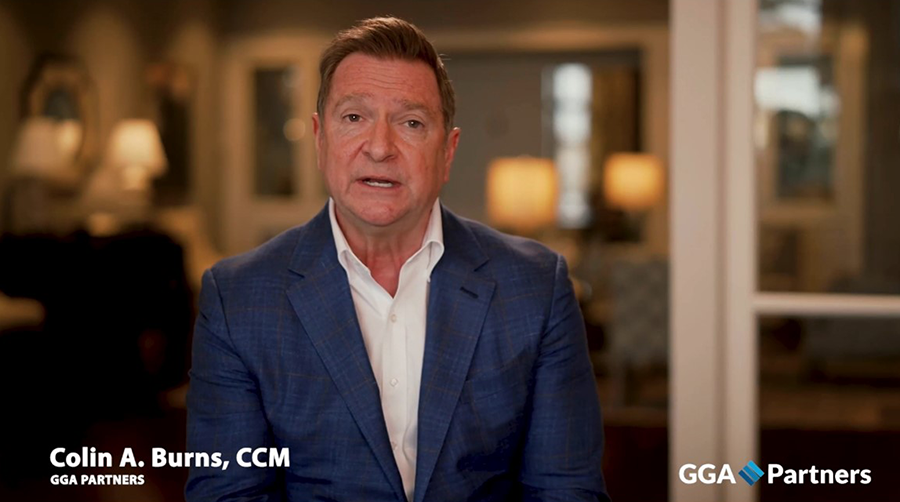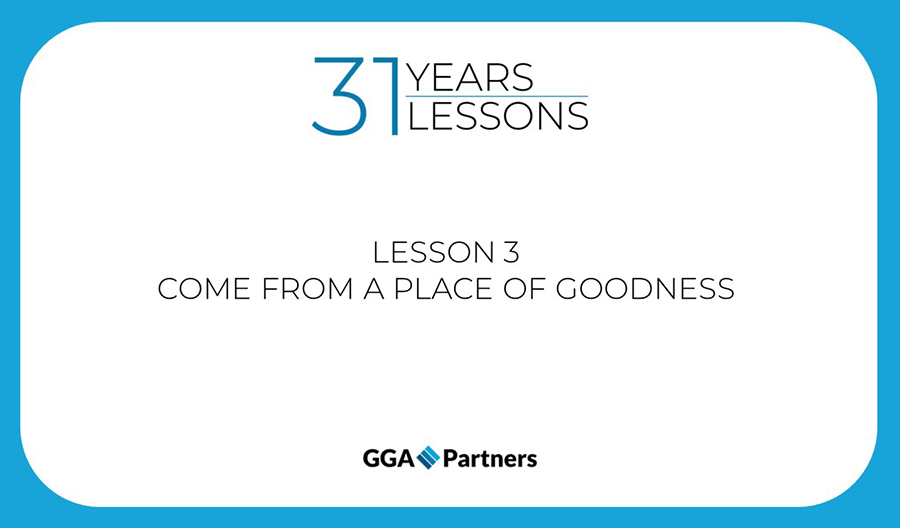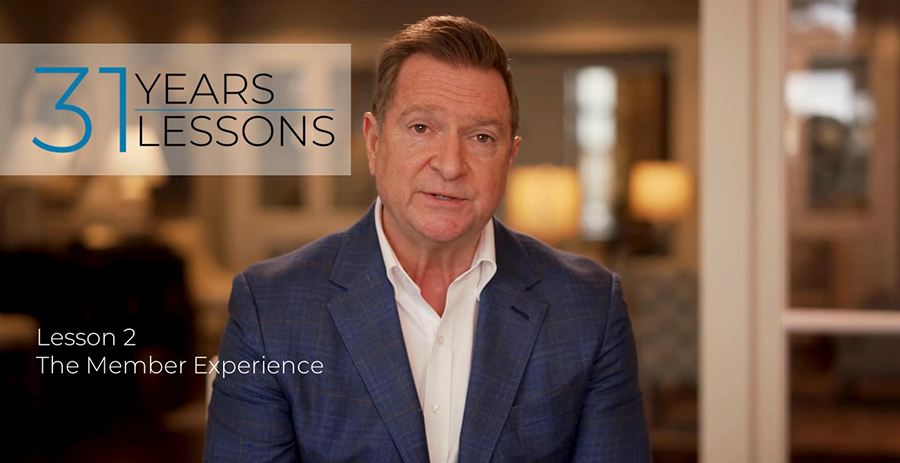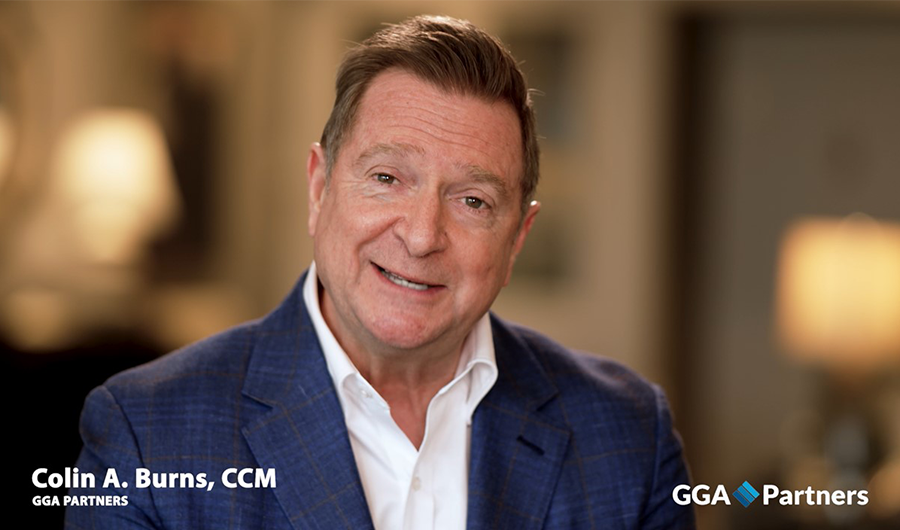
Lesson #7
of GGA Director Colin Burns’
31 years | 31 Lessons
Collaborative Leadership

Lesson #6
of GGA Director Colin Burns’
31 years | 31 Lessons speaks to
how to provide inclusive hospitality

The GGA Partners 31 Years | 31 Lessons featuring Colin Burns continues with explaining how coming from a place of goodness will be remembered.
ADDRESSING TRANSPARENCY
THREE FACTORS CRITICAL TO HIGHLY EFFECTIVE PRIVATE CLUB BOARDS
As society becomes more open and increasingly skeptical, club members demand greater transparency from their boards. Whether in member focus groups, general meetings of members or the club dining room, members seek greater transparency.
Three factors are proving critical to highly effective private club boards: (a) communication methods, (b) communication cadence, and (c) nondisclosure rules.
Boards are encouraged to heed three primary factors:
Establish and normalize the board’s communication methods. Develop a comprehensive communication plan for the club and make board communications an important and consistent part of the club’s communications. In so doing consider:
1. Topics of interest – Most club members seek a sense of “belonging.” See that they are invited to suggest topics of interest to them. In most clubs, that roster of needs includes activities and events, human interest stories about fellow members and staff, and the latest programs for each member segment. To ensure a sense of inclusion, see that members are aware of important activities well in advance of the sign-up or registration periods.
2. Multiple media options – Rely upon a wide array of media tools ranging from social media, email, postcards, and posters within club buildings. Most clubs serve multiple generations with preferred and most commonly used media options. Recognize that different subsets of the club’s members – separated by gender interests and generational media usage – require recognition and programming.
Maintain a reliable cadence of communications. Establish, announce and honor a realistic cadence of communications by topic and by membership category to help your members know what to expect and when. There are several keys to an effective communications cadence:
1. Communications profile – Develop an understanding of communications preferences for each member. Understand when – by day of the week and time of day – each member wants communications from the club. Understand what media options each member prefers. Use it.
2. Communications calendar – Publish the communications calendar to enable all members to watch for the topics of greatest interest to them. Keep it. Ensure that members and staff are well aware of the schedule and have ready access to each communication.
3. “Big events” communications – For the most popular club-wide events, such as the member-guest, holidays with Santa, parent-child dance, interrupt the normal cadence to draw attention to these special occasions.
Be transparent about the topics which will not be disclosed. Some topics – such as matters of club member discipline, employee compensation and benefits, and contract negotiations while in process – are confidential and should not be disclosed. Make it clear to members that topics require confidentiality of board members … and honor that confidentiality requirement. Be understanding and consistent to demonstrate that the board seeks the openness many members desire except on these important points.
Be transparent about what topics the board will not divulge for reasons of confidentiality and employee/member privacy. Some members want to see board meeting minutes and the club’s financial information, such as the balance sheet and income statement. The board should develop and broadly communicate what information it will share with members and in what format. The board is well advised to remember that these reports should be considered confidential and, therefore, not readily distributed outside of the club membership.
Beyond members’ demands for greater transparency, effective boards want club members to be well-informed and engaged with their clubs. Private club boards must maintain highly effective, truthful and consistent communications with club members. The rewards are greater member satisfaction, member engagement and a restful night’s sleep for board members.
This article was written by GGA’s Henry DeLozier for The Boardroom Magazine. It appeared in the March/April 2024 issue.

GGA Director Colin Burns, CCM, brings his print ad to life in a new video highlighting his beliefs about the role of an executive search consultant.

GGA Director Colin Burns, CCM, shares his Winged Foot Golf Club lessons learned about the member experience.

Managing a private club is not an easy task. It requires knowledge, stamina, fortitude, patience and a sense of humor. With each new year comes new challenges, opportunities and lessons to learn.
When GGA Director Colin Burns, CCM, joined the firm, he shared the lessons he learned over a lifetime in the hospitality industry, as an advocate for club management and his three decades as the general manager of Winged Foot Golf Club with our team. In hearing those lessons, we were reminded how success comes from doing the right thing every day.
We asked Colin to record his common sense and professional advise for us to share with you. Today we present the first of Colin’s 31 Years | 31 Lessons videos. We will be releasing all 31 on our LinkedIn page over the next several months in the hope you find these lessons helpful as you navigate your own path to success as a leader in our industry.
What do people think when you walk into a room, open your mouth to speak, or engage with others? Are they excited for what is about to happen? How do they see you, and how do they experience you? What happens as a result of your presence?
Senior leaders are increasingly discussing Executive Presence – what it is and how to have more of it. No matter how you define it, it has much to do with how we influence others. To be clear, Executive Prescence is not about how many followers you have on your social profiles but rather, how you connect, communicate, care, and impact others.
In his recent book, “The Gift of Influence”, Tommy Spaulding reveals how we can be more mindful and effective in wielding influence throughout a lifetime of connecting with others. He outlines research that suggests the average person will influence up to 80,000 people in their lifetime – about the size of a football stadium. He suggests that “If you commit to living a life of positive influence, you will never look at your personal and professional relationships the same way again.” “Leadership is not about influence. It is influence.”
Influence has everything to do with leading in the boardroom, the staff room, and beyond. Here are some considerations on how to elevate your presence, your influence and your life.
Trust – The Strongest Foundation
All relationships start and end with trust. Think about the best board relationship of your career or greatest team you have ever been a part of. What was the level of trust?
If you want to build trust with others, make sure you are trustworthy yourself as well as trusting of others. This doesn’t mean establishing blind trust without questioning. It means that we always have the intention of trust.
Years ago, author Stephen Covey likened trust to an emotional bank account. As with a real bank account, we want the balance to be at its highest. And so, it is true with a trust account. When the balance is high, the relationship is easy, more productive, and positive influence occurs. On the other hand, a low trust account breeds an environment of fear, a lack of engagement, negative influence and limited results.
Ensure you are making more deposits than withdrawals into your trust account with others: Be upfront. Be clear with your intentions. Do what you say you will do. Find the answers. Show you care. Acknowledge others.
Communication – A Main Ingredient
Most great influencers are extraordinary communicators. They understand that the words they say are powerful, and the way they say them is even more. They get to the point – and they have one! Brevity and clarity are their style. They say what they mean and mean what they say. They speak with good intentions. They have the good of the other person and the organization in mind, not themselves. A great communicator uses the language of vision and possibility.
In the leadership development practice, we have a saying “Say Less. Ask More.” The best leaders exercise the skill of listening more and speaking less. They are curious. They don’t have all the answers and genuinely seek them out. They ask powerful questions that engage others, explore solutions, and bring about growth. The focus shifts to others, not themselves.
A positive influencer also knows how their body language and voice add to or detract from their impact. They are purposeful yet speak with integrity and authenticity. They read the room, they remain calm under pressure, and they connect and engage others. Their eye contact, facial expressions and gestures are appropriately warm and powerful at the same time. They influence.
Humility – If You Don’t Have It, Find It
No question, you need to be competent in your role, but do you need to be the smartest person in the room?
The most purposeful leaders have the gift of humility. They let the results speak. They always give credit where it is due. They show up as competent, kind, caring leaders, and they often get amazing results. Their reputation speaks for itself, without their own input. They are keenly self-aware and always learning and growing.
Are you aware of how you “land” with others? Do you speak the language of team or individual? What message are you trying to send? Be acutely aware.
The great news about executive presence and influence is that they are learned skills. Start where you are. Dive in. Get feedback from those that you trust. Acquire some training or coaching. Change some habits and see how your positive influence soars – in the boardroom and beyond.
To have a discussion about how GGA’s Leadership Development and Coaching services can benefit your club, contact michael.gregory@ggapartners.com